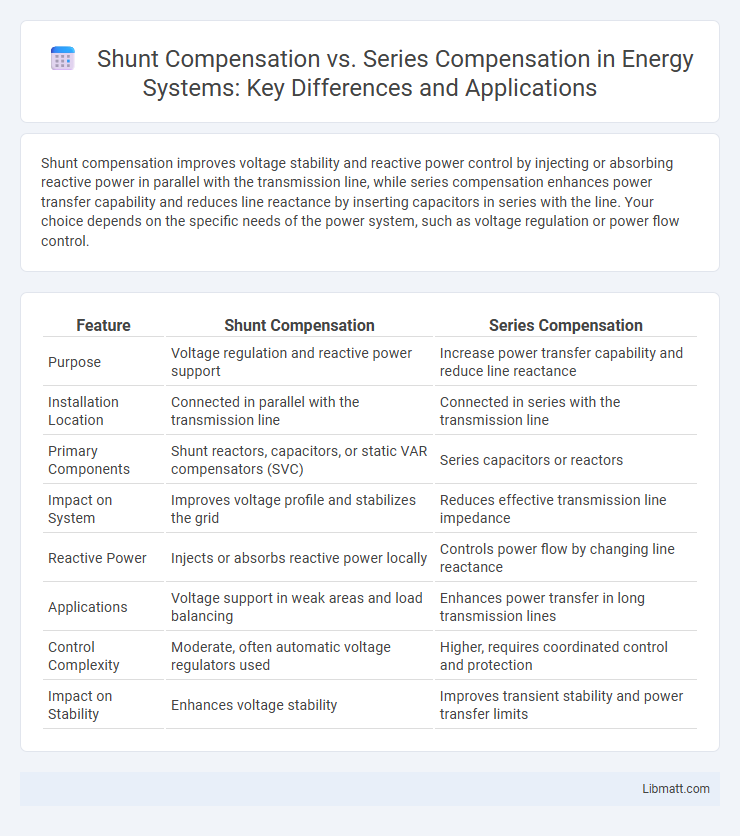Shunt compensation improves voltage stability and reactive power control by injecting or absorbing reactive power in parallel with the transmission line, while series compensation enhances power transfer capability and reduces line reactance by inserting capacitors in series with the line. Your choice depends on the specific needs of the power system, such as voltage regulation or power flow control.
Table of Comparison
| Feature | Shunt Compensation | Series Compensation |
|---|---|---|
| Purpose | Voltage regulation and reactive power support | Increase power transfer capability and reduce line reactance |
| Installation Location | Connected in parallel with the transmission line | Connected in series with the transmission line |
| Primary Components | Shunt reactors, capacitors, or static VAR compensators (SVC) | Series capacitors or reactors |
| Impact on System | Improves voltage profile and stabilizes the grid | Reduces effective transmission line impedance |
| Reactive Power | Injects or absorbs reactive power locally | Controls power flow by changing line reactance |
| Applications | Voltage support in weak areas and load balancing | Enhances power transfer in long transmission lines |
| Control Complexity | Moderate, often automatic voltage regulators used | Higher, requires coordinated control and protection |
| Impact on Stability | Enhances voltage stability | Improves transient stability and power transfer limits |
Introduction to Power System Compensation
Power system compensation enhances voltage stability and power transfer capability by managing reactive power. Shunt compensation injects or absorbs reactive power parallel to the transmission line, improving voltage regulation and reducing losses, while series compensation inserts capacitive elements in series to counteract line inductive reactance, increasing power transfer capacity and reducing line reactance. Both methods optimize system performance but target different aspects: shunt for voltage control and series for stability and transmission efficiency.
Overview of Shunt Compensation
Shunt compensation involves connecting reactive power sources, such as capacitors or inductors, in parallel with the transmission line to regulate voltage, improve power factor, and enhance system stability. This method helps maintain voltage levels during varying load conditions by supplying or absorbing reactive power directly at the busbar. Your power system benefits from reduced losses and improved voltage profile through effective shunt compensation.
Overview of Series Compensation
Series compensation involves inserting capacitors in series with transmission lines to reduce the line's reactance, thereby increasing power transfer capability and improving voltage stability. This method effectively compensates for inductive reactance, resulting in enhanced system efficiency and reduced transmission losses. In contrast to shunt compensation, series compensation directly affects the line impedance, making it ideal for long-distance, high-voltage transmission systems.
How Shunt Compensation Works
Shunt compensation works by connecting capacitors or reactors in parallel with the transmission line to regulate voltage levels and improve power factor. It supplies or absorbs reactive power locally, stabilizing voltage and reducing losses during power transmission. Your power system benefits from enhanced voltage profiles and increased load-carrying capacity through this method.
How Series Compensation Works
Series compensation works by inserting capacitors directly in series with transmission lines to offset the inductive reactance, thereby improving power transfer capability and voltage stability. This method reduces the effective line impedance, boosting the transmission efficiency and allowing higher power flow over long distances. Series compensation is particularly effective in managing power system stability and mitigating issues like voltage drops and oscillations during heavy load conditions.
Key Differences Between Shunt and Series Compensation
Shunt compensation involves connecting capacitors or reactors parallel to the transmission line to regulate voltage and improve power factor, whereas series compensation inserts capacitors in series with the line to reduce the line's reactance and increase power transfer capacity. Shunt compensation primarily enhances voltage stability and reactive power support, while series compensation targets voltage profile improvement and reduction of power losses along the line. The choice between shunt and series compensation depends on system requirements such as voltage regulation, stability enhancement, and economic efficiency in power transmission.
Advantages of Shunt Compensation
Shunt compensation offers voltage regulation, improved system stability, and enhanced reactive power control, making it ideal for maintaining voltage levels under varying load conditions. It reduces transmission losses and prevents voltage collapse by supplying or absorbing reactive power locally. Your power system benefits from increased reliability and efficiency with the use of shunt compensation devices like STATCOM and shunt capacitors.
Advantages of Series Compensation
Series compensation offers significant advantages by increasing the power transfer capability of transmission lines and improving system stability through voltage profile regulation. It reduces the effective reactance of the line, which helps in minimizing transmission losses and enhancing overall efficiency. Your power system benefits from faster dynamic response and better control of power flow, making series compensation ideal for long-distance and heavily loaded lines.
Common Applications of Each Compensation Method
Shunt compensation is commonly used in power systems for voltage regulation, reactive power support, and improving system stability, particularly in distribution networks and load centers. Series compensation is typically applied to transmission lines to increase power transfer capability, reduce line reactance, and enhance system stability over long distances. Your choice between these compensation methods depends on whether you need to manage voltage levels or boost transmission capacity.
Choosing Between Shunt and Series Compensation
Choosing between shunt and series compensation depends on the specific needs of your power system. Shunt compensation, using devices like capacitors and reactors, improves voltage stability and reactive power control by connecting parallel to the load, while series compensation, involving devices such as series capacitors, enhances power transfer capability and reduces line impedance by being connected in series with the transmission line. Your decision should consider factors like system stability, load characteristics, and the desired control over voltage or current flow.
Shunt compensation vs Series compensation Infographic

 libmatt.com
libmatt.com